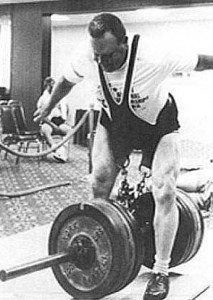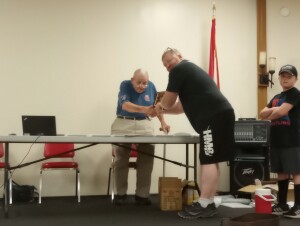By Al Myers
(Webmasters Note: Over the next month I will be running a series of biography blogs covering all past USAWA Hall of Fame members. These bios will be added to the history section, under Hall of Fame.)
HALL OF FAME BIOGRAPHY
Bill Clark – CLASS OF 1999

Bill Clark
William Merle Clark was born in Clinton, Missouri on August 18th, 1932. He graduated from Clinton High School in 1949, and then spent three years in the U.S. Army (1951-1954), including a year in Korea. Bill graduated from the University of Missouri School of Journalism in 1958, and worked briefly on the sports desk of the Lexington Kentucky Leader. He returned to Columbia Missouri in 1958, where he has lived since. Bill married Dolores Denny on August 11th, 1955 and they have five children and five grandchildren. He was a full-time major league baseball scout for 36 years (1968-2003). He retired from baseball at the end of the 2003 season and has been a columnist for the Columbia Daily Tribune since March of 2004. Bill has written for numerous baseball publications through the years and even worked as a sports reporter in the baseball off-season. He has officiated over 20 sports from the junior high school level to the international level from 1949 until today. He wrote the original Powerlifting and All-Round Weightlifting rule books and is currently writing a book about the fun of officiating more than 10,000 athletic contests. As a member of the Amateur Athletic Union (AAU) weightlifting committee (1959-1990), he was responsible for the origin of the following:
– Powerlifting as a separate sport (1964)
– Masters lifting, both Olympic Lifting and Powerlifting (1973)
– Held the first womens only Powerlifting and Olympic meets which gave the start to women’s competitive lifting (1976)
– Introduced prison weightlifting and the acceptance of inmates as full AAU members (1966). Held the first prison weightlifting postal competition (1962)
– Created the odd lifting record book (1961)
– Formation of the USAWA and the IAWA (began in 1983, finalized in 1986)
– Wrote the first USAWA and IAWA Rule Book (1986)
Bill started weightlifting in 1959 when his boxing team was looking for an off-season sport. There was not a state meet at the time, so he held the very first one in Columbia in 1959. He held the Junior Nationals and the National Teenage Championships in Columbia from 1962-1964, including the “Mr.” contests for each, along with numerous state and regional meets both in Columbia and in many prisons throughout the Midwest. He has directed over 100 meets under USAWA sanction at his gym, Clark’s Championship Gym, including the USAWA National Championships in 1995, 1997, and 2001. Bill has been the sole sponsor of the Showme State Games Powerlifting Meet since 1988. Both Bill and Dolores are in the Missouri State Games Volunteer Hall of Fame. He has had a commercial gym in Columbia since 1987, which is one of very few commercial gyms in the country that specializes in All-Round Weightlifting. Bill was the first President of the IAWA and was the Secretary of the USAWA since the beginning till 2009. He is responsible for starting the drug testing program and the certification of officials in the USAWA. Bill has published a weightlifting newsletter since 1960, which now is over its 50th year! For the first 20 years of the USAWA Bill was the editor and publisher of the publication “The Strength Journal”. At that time it was the sole source of information regarding All-Round Weightlifting in the US. Bill’s main contribution to weightlifting was the origin of the masters program. The idea came to the table in 1973 at the AAU convention, and was approved by a laugh with the mention of old people wanting to lift and compete. In 1974, only four lifters entered the National Masters Meet – Jim Witt, Jack Lano, Wilbur Miller, and Bill Clark. The Meet was cancelled that year. In 1975, the meet was held in Columbia with 15 entries. Today, the masters program is found in 70 nations and accepted without question. Master lifters outnumber open lifters in the US today. Bill was one of a half-dozen people who brought Powerlifting to the committee floor of the AAU in 1962, and saw it approved two years later as a sport by the AAU. Today, Powerlifting has expanded far beyond Olympic Lifting as a sport. In 1976, Bill violated the IWF rules which limited lifting to males only, and worded a sanction which made a combined Power/Olympic lifting competition into an all-female meet. It broke the gender barrier and women’s weightlifting was off and running. Bill commented, “In retrospect, I take pride in being the driving force to establish Powerlifting, women’s lifting, prison lifting, master’s lifting, odd lifting – and seeing them all grow and prosper.” Bill holds over 200 records in the USAWA, with most of them occurring after multiple joint replacements. Bill said, “I do take pride in my hip and harness lifts that were done after four joints – both knees and both hips – were totally replaced and being able to remain competitive with the youngsters in the finger lifts. Age and replacements have slowed the competitive urge today, particularly with the loss of cartilage in both the upper and lower spine.” In his earlier years, Bill was best known and seldom beaten in the Zercher and Steinborn lifts, once doing 460# in the Zercher and 455# in the Steinborn on the same day. There has not been an USAWA member since capable of doing this. When asked if he had any special memories of a competition, Bill replied, ” The one I most remember was in 1994 in Middletown Pennsylvania when I made a hip lift with 1400 pounds, less than five months after I had a double joint replacement – the right knee and the right hip on the the same day – a double only a few have tried!” Bill Clark will always be known as the “Founder of All-Round Weightlifting”, and his influences and contributions to the iron game will forever be felt. His last comment was this, “It has been a good 50 year run in the weight game. I’m now looking for time to go through voluminous files and to do a book I’ve promised myself for years, titled, An Irreverent History of Weightlifting.”

